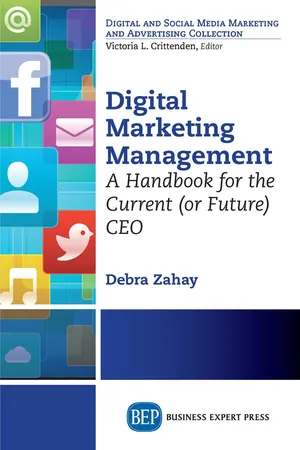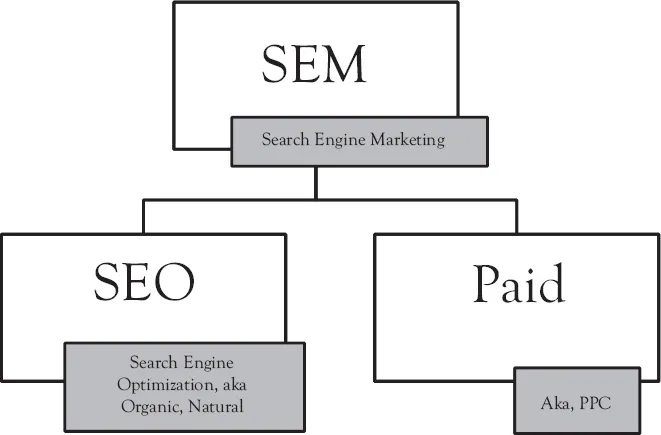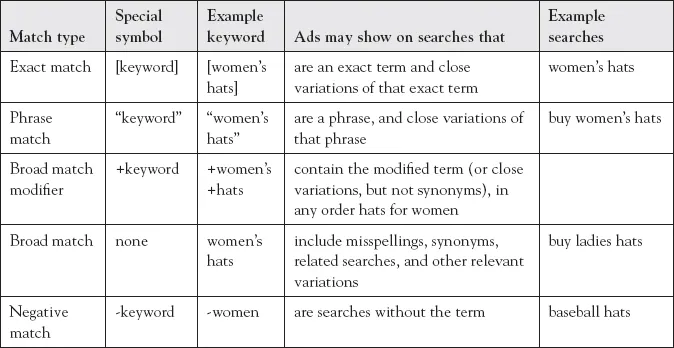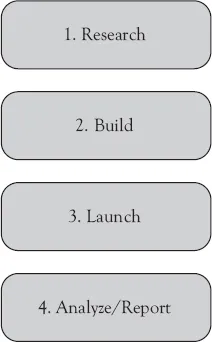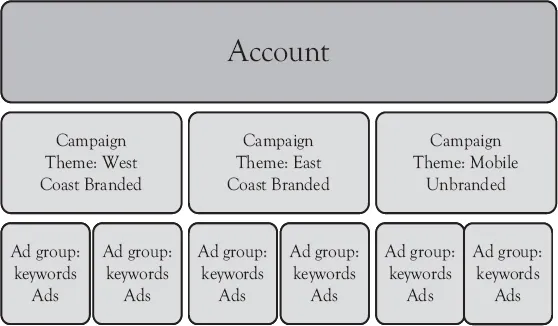![]() Delivery
Delivery![]()
CHAPTER 4
Search Engine Marketing
This chapter is the first of three chapters that involve putting positioning strategy to work (Delivery). In this chapter we will discuss both aspects of search engine marketing (SEM), paid and organic search as well as the search marketing process and how it relates to positioning strategy and branding. At the end of this section you should have a better idea as to how search relates to digital strategy.
The Search Process and Strategy
Since we have decided that the basic tenants of corporate strategy apply in the world of digital marketing, we can then apply these tenants in the world of search. There is an old adage that if you don’t know where you are going any road will get you there. The same idea can be applied in SEM. If you don’t know who you are and who you are trying to target, then you won’t be able to figure out how you need to present yourself on the web.
I like to say that search really is strategy. The reason I say this is that search is how people find your product. Most purchases today start with an online search, making an online search presence critically important. As stated previously, it is estimated that 93 percent of purchase decisions begin with search so if a company doesn’t know who it is or what keywords are important to customers, it can’t be found online.26
Critical to search marketing is the concept of the keyword. In this context, a keyword is a word or phrase that users employ to search on the Internet, hoping to get to the information they need. Sometimes users type in actual questions as keywords. Keywords can be used loosely because keywords are increasingly phrases. As users have become more sophisticated in search, they want to target exactly what they are seeking. Google understands this trend and has changed its search engine to accommodate these longer searches. The key to finding the right keyword is to know your customers and prospects well and what their intention is when they search.27 In addition to talking to our customers and using Google Trends, tools like the keywordtool,io and the Keyword Planner in Google AdWords help us to see common search trends and understand the customer’s search intention.
Figure 4.1 Types of search engine marketing
The process of search marketing is called SEM. Essentially there are two different types of search with which marketers are concerned (Figure 4.1). These types of search are paid search, often called pay-per-click (PPC) and unpaid search. The process of paying for search involves paying for advertising that show up on the top or the side (and sometimes the bottom) of the Search Engine Results Page (SERP). This type of search marketing is called paid search because the advertiser pays the website hosting the advertising (Google, Yahoo!, Bing, etc.) money every time someone clicks on an advertisement.
Paid Search
Paid search must also be considered in terms of strategy as well. Paid search means advertisements that show up at the top and side (sometimes the bottom) of SERP. For Google search results, people tend to look vertically, which means that the sponsored ads on the right side of the page are being viewed less. While 36 percent of clicks are on the fourth position or higher, even being in the first position in paid search is not important if no one clicks on the ad or if you don’t get the desired conversion. When setting up a paid search campaign through Google, Yahoo! Bing, or any other vendor, keywords are critically important. Again, the appropriate keywords must match how a product or service is perceived by the customer, their search intention, and how they search for the category. Goodle AdWords is the best known and used form of paid search, but paid search advertising can also be employed in other search engines, blogs, and social media platforms such as Facebook.
In Google AdWords, for example, we can set up how we want to be displayed based on match type, as noted in Figure 4.2. Users can search using the modifiers and punctuation below to increase their chances of a relevant search result. The type of match selected depends on the product and the campaign results. In general, broad match will give us the most advertising display but not necessarily the most relevant results so a modifier can help.
Figure 4.2 Match types for selection in Google AdWords
Phrase match is often the best choice because it will display our ad as a variation of a phrase that may be relevant to our campaign objectives. It is always good to include negative (sometimes called excluded) matches such as things for which we don’t want to be found. For example, if we sell hats but not baseball hats we can include baseball and baseball hats as negative matches.
An important aspect of paid search is the cost of the campaign. When someone clicks on an ad, the company placing the ad pays the vendor the cost, known as a “click.” Paid search can be expensive, with the average cost per click (CPC) about $3.50. Therefore, from a strategic point of view, managers are sometimes unwilling to be involved in paid search programs. The fear is that the program is a “black box” and that money will be thrown into the search marketing program and not recovered on a timely or cost efficient basis.
The Process
The best way to manage this process is to make sure that you are using a search firm that understands the search process and to have a clear plan or if you are doing this yourself to also have a clear plan in place. You will need to plan and make adjustments along the way based on the immediate feedback the Internet provides. A planning process can apply to both paid and organic search. A suggested process is shown in Figure 4.3. The process begins with researching appropriate keywords and their costs, building the campaign, launching and then analyzing, and reporting. Typically for paid search campaigns on Google there will be analytics such as average ad position, quality score, and CPC. The quality score is essentially the relevance of terminology on the advertiser’s web page to the keywords which they are using. For organic search programs it will be necessary to use Google analytics and/or another analytical tool to understand where your search traffic is coming from and which keywords are most effective in the campaigns.
Figure 4.3 Four main phases of search engine marketing planning
The process alone suggests that the search campaign be broken into manageable and measureable sections so to clearly measure the results. In Google AdWords these segments or sections are called AdGroups. By setting up groups for different products or offers, you can measure the results of campaigns. You can also do online testing of particular campaigns and ads versus what has worked previously (known as A/B testing as discussed in Chapter 3) and conversion tracking. A conversion is anything that you want to happen as the result of your marketing efforts. In the case of a paid search campaign, we often send those who click to a specific landing page, again for tracking purposes. These landing pages then can have a “conversion” action on them, like clicking through to another website or purchasing a product or downloading a whitepaper.
Figure 4.4 shows how an account can be set up in any paid search environment. This structure can apply, for example, to ads in both Facebook and Google. From a managerial perspective, it is the researching and organizing the account sub-levels that is most critical. Without these levels, it is impossible to determine results and to allocate budget. There might be different campaigns for selling products such as mobile access devices such as tablets versus the newer, larger phone (“phablet”). One campaign can be for the East Coast and another for the West Coast and have a different focus; campaigns can be set up as branded or nonbranded. Once you have established campaign themes then you can set up different groupings known as AdGroups with different keywords and ads associated with them for measurement purposes, selling Apple versus Android products, for example.
Figure 4.4 Organizing a paid search campaign
Advertisers in AdWords also have the option to display on the search network or the display network, which allows them to show the ads on websites that are most relevant to those buying your product. The search network is the general network that we see when searching Google. The display network allows ads to be targeted on relevant sites such as The Wall Street Journal for financial products or a sports site for a weight loss product. For Facebook advertising, it is possibly to target specific demographics. I heard of someone bidding on such a specific demographic in terms of age, sex, and location that he was able to deliver a highly targeted anniversary wish to his wife on Facebook!
Whatever the target market and the goal, it is most important to have a process in place for both paid and organic search, to know who the target market is and to understand the importance of each element of the campaign. For paid search, a budget is important. Search, once the alternative for those marketers who were cost-conscious, has now become big business and expensive, so keywords must be carefully chosen and budgets managed effectively.
In fact, Paid search marketing is so big that the industry is predicted to reach $21 billion by 2015, and is growing at a 13 percent rate.28 Google dominates the search market with almost 70 percent share globally,29 taking most of its growth recently from decline market share at Yahoo! Google’s historic dominance has come from its being considered a trusted organic search source that returns the best results.
In paid search, as mentioned above, advertisers create ads and bid on the keywords, paying when a searcher clicks on the ad. The paid search process is somewhat akin to an auction, but the top ranked ad does not always go to the highest bidder. Other factors such as quality score can determine how well placed the ad is on the search page and if it gets served at all. Ads typically display on the right hand side of the search page. The order of the ad is referred to as the ad position, with the top ad having position 1, the next position 2, and so on. Advertisers typically try to be somewhere between position 2 and 3 to avoid paying too much for their ad placement. Most clicks occur in the first few positions. Typically, users look at the top ads and do not scroll down to position 10.
Organic Search
This careful process of planning and measurement relates to organic search as well. The unpaid type of search is known as organic or natural search and the process of getting ranked “naturally” is known as search engine optimization (SEO). This SEO process involves an understanding of what is known as a search algorithm. An algorithm helps the search engine decide which pages come closest to which queries on the Internet. The natural or organic search results show up below and to the left side of the advertisements on the search engine results page. Google makes changes to the search Algorithm periodically. These changes are usu...
